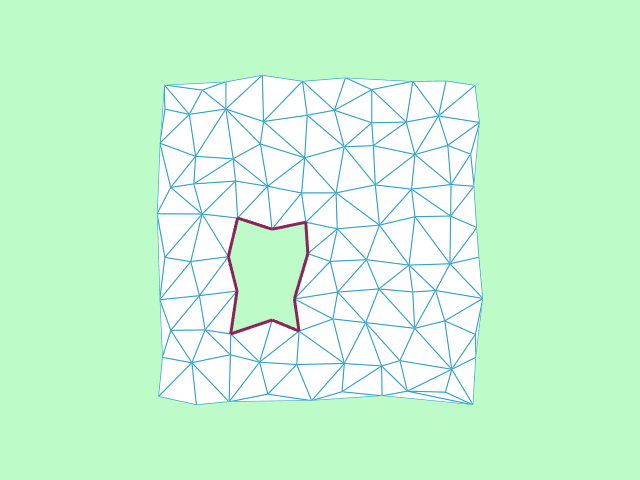ConstrainedDelaunay2D
Repository source: ConstrainedDelaunay2D
Description¶
Perform a 2D Delaunay triangulation respecting a specified boundary. This examples constructs a 10x10 grid of points. It then defines a polygon that uses the points in the grid. We want to triangulate all of the points except the region inside the boundary of the polygon. We expect a rectangular hole of size 4x3 in the resulting triangulated plane.
Other languages
See (Cxx), (PythonicAPI)
Question
If you have a question about this example, please use the VTK Discourse Forum
Code¶
ConstrainedDelaunay2D.py
#!/usr/bin/python
# noinspection PyUnresolvedReferences
import vtkmodules.vtkInteractionStyle
# noinspection PyUnresolvedReferences
import vtkmodules.vtkRenderingOpenGL2
from vtkmodules.vtkCommonColor import vtkNamedColors
from vtkmodules.vtkCommonCore import (
vtkMinimalStandardRandomSequence,
vtkPoints
)
from vtkmodules.vtkCommonDataModel import (
vtkCellArray,
vtkPolyData,
vtkPolygon
)
from vtkmodules.vtkFiltersCore import vtkDelaunay2D
from vtkmodules.vtkRenderingCore import (
vtkActor,
vtkPolyDataMapper,
vtkRenderWindow,
vtkRenderWindowInteractor,
vtkRenderer
)
def main():
colors = vtkNamedColors()
# Generate a 10 x 10 grid of points
points = vtkPoints()
gridSize = 10
seed = 0
randomSequence = vtkMinimalStandardRandomSequence()
randomSequence.Initialize(seed)
for x in range(gridSize):
for y in range(gridSize):
d1 = randomSequence.GetValue() / 2.0 - 0.25
randomSequence.Next()
d2 = randomSequence.GetValue() / 2.0 - 0.25
randomSequence.Next()
points.InsertNextPoint(x + d1, y + d2, 0)
aPolyData = vtkPolyData()
aPolyData.SetPoints(points)
# Create a cell array to store the polygon in
aCellArray = vtkCellArray()
# Define a polygonal hole with a clockwise polygon
aPolygon = vtkPolygon()
aPolygon.GetPointIds().InsertNextId(22)
aPolygon.GetPointIds().InsertNextId(23)
aPolygon.GetPointIds().InsertNextId(24)
aPolygon.GetPointIds().InsertNextId(25)
aPolygon.GetPointIds().InsertNextId(35)
aPolygon.GetPointIds().InsertNextId(45)
aPolygon.GetPointIds().InsertNextId(44)
aPolygon.GetPointIds().InsertNextId(43)
aPolygon.GetPointIds().InsertNextId(42)
aPolygon.GetPointIds().InsertNextId(32)
aCellArray.InsertNextCell(aPolygon)
# Create a polydata to store the boundary. The points must be the
# same as the points we will triangulate.
boundary = vtkPolyData()
boundary.SetPoints(aPolyData.GetPoints())
boundary.SetPolys(aCellArray)
# Triangulate the grid points
delaunay = vtkDelaunay2D()
delaunay.SetInputData(aPolyData)
delaunay.SetSourceData(boundary)
# Visualize
meshMapper = vtkPolyDataMapper()
meshMapper.SetInputConnection(delaunay.GetOutputPort())
meshActor = vtkActor()
meshActor.SetMapper(meshMapper)
meshActor.GetProperty().EdgeVisibilityOn()
meshActor.GetProperty().SetEdgeColor(colors.GetColor3d('Peacock'))
meshActor.GetProperty().SetInterpolationToFlat()
boundaryMapper = vtkPolyDataMapper()
boundaryMapper.SetInputData(boundary)
boundaryActor = vtkActor()
boundaryActor.SetMapper(boundaryMapper)
boundaryActor.GetProperty().SetColor(colors.GetColor3d('Raspberry'))
boundaryActor.GetProperty().SetLineWidth(3)
boundaryActor.GetProperty().EdgeVisibilityOn()
boundaryActor.GetProperty().SetEdgeColor(colors.GetColor3d('Red'))
boundaryActor.GetProperty().SetRepresentationToWireframe()
# Create a renderer, render window, and interactor
renderer = vtkRenderer()
renderWindow = vtkRenderWindow()
renderWindow.AddRenderer(renderer)
renderWindowInteractor = vtkRenderWindowInteractor()
renderWindowInteractor.SetRenderWindow(renderWindow)
# Add the actor to the scene
renderer.AddActor(meshActor)
renderer.AddActor(boundaryActor)
renderer.SetBackground(colors.GetColor3d('Mint'))
# Render and interact
renderWindow.SetSize(640, 480)
renderWindow.SetWindowName('ConstrainedDelaunay2D')
renderWindow.Render()
renderWindowInteractor.Start()
if __name__ == '__main__':
main()
